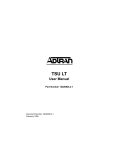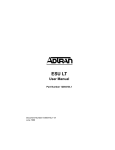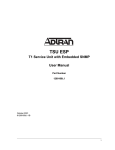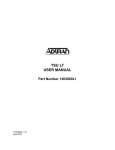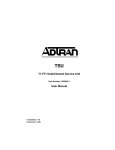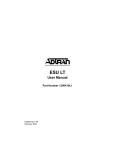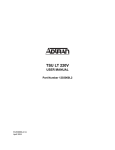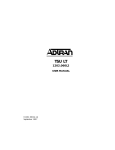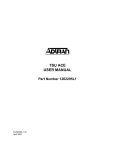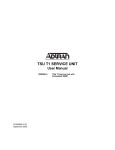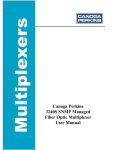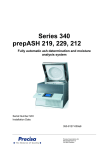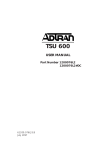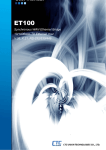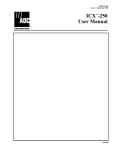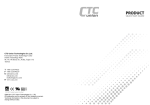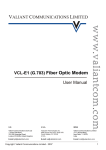Download TSU LT User Manual (Rev A)
Transcript
TSU LT User Manual 61202060L4-1A May 2002 1202060L2 TSU LT with V.35 220 VAC 1202060L4 TSU LT with V.11 220 VAC Trademarks Any brand names and product names included in this manual are trademarks, registered trademarks, or trade names of their respective holders. To the Holder of the Manual The contents of this manual are current as of the date of publication. ADTRAN reserves the right to change the contents without prior notice. In no event will ADTRAN be liable for any special, incidental, or consequential damages or for commercial losses even if ADTRAN has been advised thereof as a result of issue of this publication. 901 Explorer Boulevard P.O. Box 140000 Huntsville, AL 35814-4000 Phone: (256) 963-8000 ©2002 ADTRAN, Inc. All Rights Reserved. Printed in U.S.A. 2 © 2002 ADTRAN, Inc. 61202060L4-1A Notes provide additional useful information. Cautions signify information that could prevent service interruption. Warnings provide information that could prevent damage to the equipment or endangerment to human life. Safety Instructions When using your telephone equipment, please follow these basic safety precautions to reduce the risk of fire, electrical shock, or personal injury: 1. Do not use this product near water, such as a bathtub, wash bowl, kitchen sink, laundry tub, in a wet basement, or near a swimming pool. 2. Avoid using a telephone (other than a cordless-type) during an electrical storm. There is a remote risk of shock from lightning. 3. Do not use the telephone to report a gas leak in the vicinity of the leak. 4. Use only the power cord, power supply, and/or batteries indicated in the manual. Do not dispose of batteries in a fire. They may explode. Check with local codes for special disposal instructions. Compliance Double pole/neutral fusing. The socket-outlet shall be installed near the equipment and shall be easily accessible. Save These Important Safety Instructions 61202060L4-1A © 2002 ADTRAN, Inc. 3 Affidavit Requirements for Connection to Digital Services • • • An affidavit is required to be given to the telephone company whenever digital terminal equipment without encoded analog content and billing protection is used to transmit digital signals containing encoded analog content which are intended for eventual conversion into voiceband analog signals and transmitted on the network. The affidavit shall affirm that either no encoded analog content or billing information is being transmitted or that the output of the device meets Part 68 encoded analog content or billing protection specifications. End user/customer will be responsible for filing an affidavit with the local exchange carrier when connecting unprotected customer premise equipment (CPE) to 1.544 Mbps or subrate digital services. Until such time as subrate digital terminal equipment is registered for voice applications, the affidavit requirement for subrate services is waived. 4 © 2002 ADTRAN, Inc. 61202060L4-1A Affidavit for Connection of Customer Premises Equipment to 1.544 Mbps and/or Subrate Digital Services For the work to be performed in the certified territory of ___________________ (telco name) State of ________________ County of ________________ I, _______________________ (name), ____________________________________ (business address), ____________________ (telephone number) being duly sworn, state: I have responsibility for the operation and maintenance of the terminal equipment to be connected to 1.544 Mbps and/or ________ subrate digital services. The terminal equipment to be connected complies with Part 68 of the FCC rules except for the encoded analog content and billing protection specifications. With respect to encoded analog content and billing protection: ( ) I attest that all operations associated with the establishment, maintenance, and adjustment of the digital CPE with respect to analog content and encoded billing protection information continuously complies with Part 68 of the FCC Rules and Regulations. ( ) The digital CPE does not transmit digital signals containing encoded analog content or billing information which is intended to be decoded within the telecommunications network. ( ) The encoded analog content and billing protection is factory set and is not under the control of the customer. I attest that the operator(s)/maintainer(s) of the digital CPE responsible for the establishment, maintenance, and adjustment of the encoded analog content and billing information has (have) been trained to perform these functions by successfully having completed one of the following (check appropriate blocks): ( ) A. A training course provided by the manufacturer/grantee of the equipment used to encode analog signals; or ( ) B. A training course provided by the customer or authorized representative, using training materials and instructions provided by the manufacturer/grantee of the equipment used to encode analog signals; or ( ) C. An independent training course (e.g., trade school or technical institution) recognized by the manufacturer/grantee of the equipment used to encode analog signals; or 61202060L4-1A © 2002 ADTRAN, Inc. 5 ( ) D. In lieu of the preceding training requirements, the operator(s)/maintainer(s) is (are) under the control of a supervisor trained in accordance with _________ (circle one) above. I agree to provide ______________________ (telco’s name) with proper documentation to demonstrate compliance with the information as provided in the preceding paragraph, if so requested. _________________________________Signature _________________________________Title _________________________________ Date Transcribed and sworn to before me This ________ day of _______________, _______ _________________________________ Notary Public My commission expires: _________________________________ 6 © 2002 ADTRAN, Inc. 61202060L4-1A FCC regulations require that the following information be provided in this manual: 1. This equipment complies with Part 68 of FCC rules. On the back of the equipment housing is a label showing the FCC registration number and ringer equivalence number (REN). If requested, provide this information to the telephone company. 2. If this equipment causes harm to the telephone network, the telephone company may temporarily discontinue service. If possible, advance notification is given; otherwise, notification is given as soon as possible. The telephone company will advise the customer of the right to file a complaint with the FCC. 3. The telephone company may make changes in its facilities, equipment, operations, or procedures that could affect the proper operation of this equipment. Advance notification and the opportunity to maintain uninterrupted service are given. 4. If experiencing difficulty with this equipment, please contact ADTRAN for repair and warranty information. The telephone company may require this equipment to be disconnected from the network until the problem is corrected or it is certain the equipment is not malfunctioning. 5. This unit contains no user-serviceable parts. 6. An FCC compliant telephone cord with a modular plug is provided with this equipment. This equipment is designed to be connected to the telephone network or premises wiring using an FCC compatible modular jack, which is Part 68 compliant. 7. The following information may be required when applying to the local telephone company for a dial-up line for the V.34 modem: Service Type REN FIC USOC 1.544 Mbps - SF 04DU9-BN 6.0N RJ-48C 1.544 Mbps - SF and B8ZS 04DU9-DN 6.0N RJ-48C 1.544 Mbps - ESF 04DU9-1KN 6.0N RJ-48C 1.544 Mbps - ESF and B8ZS 04DU9-1SN 6.0N RJ-48C 8. The REN is useful in determining the quantity of devices you may connect to your telephone line and still have all of those devices ring when your number is called. In most areas, the sum of the RENs of all devices should not exceed five. To be certain of the number of devices you may connect to your line as determined by the REN, call your telephone company to determine the maximum REN for your calling area. 9. This equipment may not be used on coin service provided by the telephone company. Connection to party lines is subject to state tariffs. Contact your state public utility commission or corporation commission for information. 61202060L4-1A © 2002 ADTRAN, Inc. 7 Federal Communications Commission Radio Frequency Interference Statement This equipment has been tested and found to comply with the limits for a Class A digital device, pursuant to Part 15 of the FCC Rules. These limits are designed to provide reasonable protection against harmful interference when the equipment is operated in a commercial environment. This equipment generates, uses, and can radiate radio frequency energy and, if not installed and used in accordance with the instruction manual, may cause harmful interference to radio frequencies. Operation of this equipment in a residential area is likely to cause harmful interference in which case the user will be required to correct the interference at his own expense. Shielded cables must be used with this unit to ensure compliance with Class A FCC limits. Changes or modifications to this unit not expressly approved by the party responsible for compliance could void the user’s authority to operate the equipment. 8 © 2002 ADTRAN, Inc. 61202060L4-1A Industry Canada Compliance Information Notice: The Industry Canada label applied to the product (identified by the Industry Canada logo or the “IC:” in front of the certification/registration number) signifies that the Industry Canada technical specifications were met. Notice: The Ringer Equivalence Number (REN) for this terminal equipment is supplied in the documentation or on the product labeling/markings. The REN assigned to each terminal device indicates the maximum number of terminals that can be connected to a telephone interface. The termination on an interface may consist of any combination of devices subject only to the requirement that the sum of the RENs of all the devices should not exceed five (5). Canadian Emissions Requirements This digital apparatus does not exceed the Class A limits for radio noise emissions from digital apparatus as set out in the interference-causing equipment standard entitled “Digital Apparatus,” ICES-003 of the Department of Communications. Cet appareil numérique respecte les limites de bruits radioelectriques applicables aux appareils numériques de Class A prescrites dans la norme sur le materiel brouilleur: “Appareils Numériques,” NMB-003 edictee par le ministre des Communications. 61202060L4-1A © 2002 ADTRAN, Inc. 9 Warranty and Customer Service ADTRAN will repair and return this product within 5 years from the date of shipment if it does not meet its published specifications or fails while in service. For detailed warranty, repair, and return information refer to the ADTRAN Equipment Warranty and Repair and Return Policy Procedure. Return Material Authorization (RMA) is required prior to returning equipment to ADTRAN. For service, RMA requests, or further information, contact one of the numbers listed at the end of this section. LIMITED PRODUCT WARRANTY ADTRAN warrants that for 5 years from the date of shipment to Customer, all products manufactured by ADTRAN will be free from defects in materials and workmanship. ADTRAN also warrants that products will conform to the applicable specifications and drawings for such products, as contained in the Product Manual or in ADTRAN's internal specifications and drawings for such products (which may or may not be reflected in the Product Manual). This warranty only applies if Customer gives ADTRAN written notice of defects during the warranty period. Upon such notice, ADTRAN will, at its option, either repair or replace the defective item. If ADTRAN is unable, in a reasonable time, to repair or replace any equipment to a condition as warranted, Customer is entitled to a full refund of the purchase price upon return of the equipment to ADTRAN. This warranty applies only to the original purchaser and is not transferable without ADTRAN's express written permission. This warranty becomes null and void if Customer modifies or alters the equipment in any way, other than as specifically authorized by ADTRAN. EXCEPT FOR THE LIMITED WARRANTY DESCRIBED ABOVE, THE FOREGOING CONSTITUTES THE SOLE AND EXCLUSIVE REMEDY OF THE CUSTOMER AND THE EXCLUSIVE LIABILITY OF ADTRAN AND IS IN LIEU OF ANY AND ALL OTHER WARRANTIES (EXPRESSED OR IMPLIED). ADTRAN SPECIFICALLY DISCLAIMS ALL OTHER WARRANTIES, INCLUDING (WITHOUT LIMITATION), ALL WARRANTIES OF MERCHANTABILITY AND FITNESS FOR A PARTICULAR PURPOSE. SOME STATES DO NOT ALLOW THE EXCLUSION OF IMPLIED WARRANTIES, SO THIS EXCLUSION MAY NOT APPLY TO CUSTOMER. In no event will ADTRAN or its suppliers be liable to the Customer for any incidental, special, punitive, exemplary or consequential damages experienced by either the Customer or a third party (including, but not limited to, loss of data or information, loss of profits, or loss of use). ADTRAN is not liable for damages for any cause whatsoever (whether based in contract, tort, or otherwise) in excess of the amount paid for the item. Some states do not allow the limitation or exclusion of liability for incidental or consequential damages, so the above limitation or exclusion may not apply to the Customer. 10 © 2002 ADTRAN, Inc. 61202060L4-1A Customer Service, Product Support Information, and Training ADTRAN will repair and return this product if within 5 years from the date of shipment the product does not meet its published specification or the product fails while in service. A return material authorization (RMA) is required prior to returning equipment to ADTRAN. For service, RMA requests, training, or more information, use the contact information given below. Repair and Return If you determine that a repair is needed, please contact our Customer and Product Service (CAPS) department to have an RMA number issued. CAPS should also be contacted to obtain information regarding equipment currently in house or possible fees associated with repair. CAPS Department (256) 963-8722 Identify the RMA number clearly on the package (below address), and return to the following address: ADTRAN Customer and Product Service 901 Explorer Blvd. (East Tower) Huntsville, Alabama 35806 RMA # _____________ 61202060L4-1A © 2002 ADTRAN, Inc. 11 Pre-Sales Inquiries and Applications Support Your reseller should serve as the first point of contact for support. If additional pre-sales support is needed, the ADTRAN Support web site provides a variety of support services such as a searchable knowledge base, latest product documentation, application briefs, case studies, and a link to submit a question to an Applications Engineer. All of this, and more, is available at: http://support.adtran.com When needed, further pre-sales assistance is available by calling our Applications Engineering Department. Applications Engineering (800) 615-1176 Post-Sale Support Your reseller should serve as the first point of contact for support. If additional support is needed, the ADTRAN Support web site provides a variety of support services such as a searchable knowledge base, updated firmware releases, latest product documentation, service request ticket generation and troubleshooting tools. All of this, and more, is available at: http://support.adtran.com When needed, further post-sales assistance is available by calling our Technical Support Center. Please have your unit serial number available when you call. Technical Support 12 (888) 4ADTRAN © 2002 ADTRAN, Inc. 61202060L4-1A Installation and Maintenance Support The ADTRAN Custom Extended Services (ACES) program offers multiple types and levels of installation and maintenance services which allow you to choose the kind of assistance you need. This support is available at: http://www.adtran.com/aces For questions, call the ACES Help Desk. ACES Help Desk (888) 874-ACES (2237) Training The Enterprise Network (EN) Technical Training Department offers training on our most popular products. These courses include overviews on product features and functions while covering applications of ADTRAN's product lines. ADTRAN provides a variety of training options, including customized training and courses taught at our facilities or at your site. For more information about training, please contact your Territory Manager or the Enterprise Training Coordinator. 61202060L4-1A Training Phone (800) 615-1176, ext. 7500 Training Fax (256) 963-6700 Training Email [email protected] © 2002 ADTRAN, Inc. 13 14 © 2002 ADTRAN, Inc. 61202060L4-1A Table of Contents Chapter 1 Introduction ...........................................................................................................21 T1/FT1 Overview ...................................................................................................................21 T1 Service Offerings .........................................................................................................21 Fractional T1 .....................................................................................................................21 TSU LT Overview ..................................................................................................................22 Functional Description ......................................................................................................22 TSU LT (P/N 1202060L2-1) Rear Panel ..........................................................................22 TSU LT (P/N 1202060L4-1) Rear Panel ..........................................................................23 TSU LT Features ..............................................................................................................24 TSU LT Interfaces ............................................................................................................24 Network Interface (NI) ...............................................................................................25 Nx56/64 Serial Interface .............................................................................................25 Control Port Input .......................................................................................................26 Chain Port Output .......................................................................................................26 Software Management ......................................................................................................26 Front Panel ..................................................................................................................26 T-Watch Pro Management Software Program ............................................................26 Testing ..............................................................................................................................26 Self-test .......................................................................................................................27 Loopback Tests ...........................................................................................................27 DTE Interface Loopbacks ...........................................................................................28 Pattern Generation ......................................................................................................28 Bridge/Router Application ................................................................................................29 Chapter 2 Installation ..............................................................................................................31 Inspecting for Damages ..........................................................................................................31 Items Shipped by ADTRAN .............................................................................................31 Items Provided by Customer .............................................................................................31 Power Connection .............................................................................................................31 Power Up Testing and Initialization .................................................................................31 Self-Test ......................................................................................................................32 Chapter 3 Operation ................................................................................................................33 Operation ................................................................................................................................33 General Menu Operation ..................................................................................................33 Menu Structure .................................................................................................................33 Four Opening Menu Functions ...................................................................................34 Menu Features ...................................................................................................................35 Data Field ....................................................................................................................35 Display Field ...............................................................................................................35 Arrows ........................................................................................................................36 61202060L4-1 © 2002 ADTRAN, Inc. 15 Table of Contents TSU LT User Manual Example Menu Operations .........................................................................................36 Front Panel ........................................................................................................................38 Chapter 4 Status Menu ............................................................................................................39 Status .......................................................................................................................................39 NI PERF RPTS .................................................................................................................39 CURR ERR/ALM .............................................................................................................40 Alarms and Errors .......................................................................................................41 ERR/ALM HIST ...............................................................................................................41 Chapter 5 Configuration Menu ..............................................................................................43 Config .....................................................................................................................................43 Network (NI) .....................................................................................................................43 Unit ...................................................................................................................................47 Port ....................................................................................................................................49 Chapter 6 Utility Menu ...........................................................................................................51 Util ..........................................................................................................................................51 Time/Date .........................................................................................................................51 Software Rev .....................................................................................................................52 Reinit Unit .........................................................................................................................52 Address .............................................................................................................................52 Set Passcode ......................................................................................................................52 Fact Restore ......................................................................................................................52 Chapter 7 Test Menu ...............................................................................................................53 Test ..........................................................................................................................................53 Network Tests ...................................................................................................................53 Local Loopback ..........................................................................................................54 Remote Loopback .......................................................................................................54 Test Pattern .................................................................................................................55 Clr Errors ....................................................................................................................55 Insert 511 errors ..........................................................................................................55 Run Self-test .....................................................................................................................56 Port Tests ..........................................................................................................................56 Chapter 8 Example Operations ..............................................................................................57 Testing Examples ....................................................................................................................57 Far End Looped Back Test ...............................................................................................57 Network Interface Test .....................................................................................................57 Wiring .....................................................................................................................................65 Network ............................................................................................................................65 Control Chain-In ...............................................................................................................66 Control Chain-Out ............................................................................................................67 Nx56K/64K DTE (V.35) ..................................................................................................68 Nx56K/64K DTE (V.11) ..................................................................................................69 16 © 2002 ADTRAN, Inc. 61202060L4-1 List of Figures Figure 1-1. Figure 1-2. Figure 1-3. Figure 1-4. Figure 1-5. Figure 1-6. Figure 1-7. Figure 3-1. Figure 3-2. Figure 3-3. Figure 3-4. Figure 3-5. Figure 4-1. Figure 4-2. Figure 4-3. Figure 4-4. Figure 5-1. Figure 5-2. Figure 5-3. Figure 5-4. Figure 5-5. Figure 5-6. Figure 5-7. Figure 6-1. Figure 6-2. Figure 6-3. Figure 7-1. Figure 7-2. Figure 7-3. Figure 7-4. Figure 7-5. Figure 8-1. Figure 8-2. Figure 8-3. Figure 8-4. Figure 8-5. Figure 8-6. Figure A-1. Figure A-2. 61202060L4-1 TSU LT Unit - Front View ..................................................................................... 22 TSU LT (w/V.35) Rear Panel ................................................................................. 22 TSU LT (w/V.11) Rear Panel ................................................................................. 23 TSU LT Interfaces .................................................................................................. 25 Network Loopback Tests ........................................................................................ 27 DTE Interface Loopback ........................................................................................ 28 Simple Bridge Application on a T1 or FT1 Circuit ................................................ 29 TSU LT Main Menus ............................................................................................. 33 TSU LT Main Menu Screen ................................................................................... 34 Cursor on Menu Item .............................................................................................. 36 Submenu Fields ...................................................................................................... 36 Front Panel Layout ................................................................................................. 38 Status Menu ............................................................................................................ 39 Severely Errored Seconds Screen ........................................................................... 40 Loss of Signal (Current Errors/Alarms) Screens .................................................... 40 Clear History Screen ............................................................................................... 42 Configuration Menu ............................................................................................... 43 Network Submenu .................................................................................................. 44 Network Timed Clock Source ................................................................................ 45 DTE Clock Source .................................................................................................. 46 Internal Clock Source ............................................................................................. 46 Configuration Submenu .......................................................................................... 47 Inband Remote Configuration ................................................................................ 50 Utility Menu ........................................................................................................... 51 Time/Date Screen ................................................................................................... 51 Address Screen ....................................................................................................... 52 Test Menu ............................................................................................................... 53 Local Loopback Screen .......................................................................................... 54 Clear Errors Screen ................................................................................................. 55 Self Test Results Screen ......................................................................................... 56 Loopback Setting Screen ........................................................................................ 56 Main Menu with TEST Selected ............................................................................ 57 Test Menu with NETWORK TESTS Selected ...................................................... 58 Local Loopback Test Menu .................................................................................... 58 Remote Loopback Test Menu ................................................................................ 58 Test Pattern Screen ................................................................................................. 59 Clear Errors Screen ................................................................................................. 60 TSU LT Menu Tree (Status and Config) ................................................................ 61 TSU LT Menu Tree (Util and Test) ....................................................................... 62 © 2002 ADTRAN, Inc. 17 List of Figures 18 TSU LT User Manual © 2002 ADTRAN, Inc. 61202060L4-1 List of Tables Table 1-1. Number Identification for TSU LT w/V.35 Rear Panel ........................................... Table 1-2. Number Identification for TSU LT w/V.11 Rear Panel ........................................... Table 5-1. Normal Mode Operation ........................................................................................... Table 6-1. Editing the Time/Date............................................................................................... Table B-1. DTE Data Rate Chart ................................................................................................ Table C-1. Network Pin Assignments ........................................................................................ Table C-2. Chain-In Pin Assignments ........................................................................................ Table C-3. Chain-Out Pin Assignments...................................................................................... Table C-4. V.35 Pin Assignment ................................................................................................ Table C-5. V.11 Pin Assignments............................................................................................... 61202060L4-1 © 2002 ADTRAN, Inc. 23 24 50 52 63 65 66 67 68 69 19 List of Tables 20 TSU LT User Manual © 2002 ADTRAN, Inc. 61202060L4-1 Chapter 1 Introduction T1/FT1 OVERVIEW T1 digital communication links have been used by the telephone companies (telcos) for voice transmission since the early sixties. The D4 channel bank is an example of a T1 digital carrier system that was introduced in the mid-seventies and is still widely used by the telcos. Communication demands of businesses continued to grow to the point that the telcos began offering T1 service directly to the public. D4 channel banks began to be used for T1 in corporate network topographies for voice. The technological advances in computer development also created a demand for T1 data communication which now is a large part of the T1 traffic. T1 Service Offerings T1 is a digital service that is delivered to the user over two pairs of wires from the service provider. The signal operates at 1.544 mega bits per second (Mbps) and is usually extended by repeaters that are installed about every mile after the first 6000 feet. The T1 signal is divided into 24 time slots or digital signal level zeros (DS0s) which operate at 64 kilo bits per seconds (kbps). Each time slot is occupied by digitized voice or by data. The T1 signal originally used a type of framing known as D4 Superframe which identifies how the T1 is multiplexed. Extended Superframe (ESF) is an enhancement of that framing format. ESF provides a nondisruptive means of full time monitoring on the digital facility. It was originally used by the service provider to monitor the performance of their service offering. Since the introduction of ESF, equipment that is installed in private networks can also provide the same performance information to the user. Fractional T1 Fractional T1 (FT1) allows the buyer to purchase less than a full T1 circuit between two points. Most carriers offer fractional T1 in increments of 56 or 64 kbps. Connection is made to the same network elements. The network allows multiple users to share the same interoffice T1 bandwidth. FT1 remains almost exclusively an inter-exchange carrier (IXC) service. Local exchange carriers (LECs) typically do not offer FT1, so the user’s proximity to the IXC’s point-of-presence (POP) is key in the savings that fractional T1 offers. FT1 local access is available in two forms: • • 56 kbps - In 56 kbps, the required number of digital data service (DDS) lines is extended from the IXC POP and the bandwidth is combined at the office on an outbound T1 circuit. The user pays for the individual 56K lines and the amount of the interoffice T1 utilized. Full T1 line - In T1 access, the user pays for a full T1 to the IXC POP and then only for the bandwidth utilized. 61202060L4-1 © 2002 ADTRAN, Inc. 21 Chapter 1. Introduction TSU LT User Manual TSU LT OVERVIEW This section provides a functional description of the TSU LT, describes its features, and illustrates its four interfaces. Figure 1-1 shows the TSU LT. Functional Description The ADTRAN TSU LT is one of several T1 multiplexers that offer complete flexibility for connection of various data sources to T1 or FT1 facilities. This family of TSU multiplexers includes the following: • • • TSU and TSU LT - T1 CSU/DSUs with a single Nx56K/64K serial port. TSU 100 - Same as the TSU with the added feature of a slot in the rear panel to house an option module. Each module offers up to four additional data ports. TSU 600 - Same as the TSU with the added feature of six slots in the rear panel to house up to six option modules. Each module offers up to four additional data ports for a total of 24 possible data ports. ENTER TEST ALM ERR PWR CANCEL TSU LT TD RD RS CS Figure 1-1. TSU LT Unit - Front View The TSU LT serves as the link between user data sources such as local area network (LAN) bridges and routers, computers, CAD systems, and teleconferencing equipment. The amount of bandwidth allocated to the port is custom programmable. The data terminal equipment (DTE) data can occupy contiguous or alternate channels in the T1 stream, and the channels may start at any position. TSU LT (P/N 1202060L2-1) Rear Panel Table 1-1 on page 23 identifies the TSU LT rear panel components illustrated in Figure 1-2. 1 2 3 4 5 6 7 8 9 Figure 1-2. TSU LT (w/V.35) Rear Panel 22 © 2002 ADTRAN, Inc. 61202060L4-1 TSU LT User Manual Chapter 1. Introduction Table 1-1. Number Identification for TSU LT w/V.35 Rear Panel No. Item Function 1 Network T1-FT1 network interface 2 In Bantam test jack 3 Out Bantam test jack 4 MON (monitor) Bantam test jack 5 Chain-In Interface of chain-in 6 Chain-Out Connects to chain-in of another TSU LT 7 V.35 Nx56/64 DTE port 8 Power Switch Used to turn power on or off 9 Power Cord Captive 3-prong power cord TSU LT (P/N 1202060L4-1) Rear Panel Table 1-2 on page 24 identifies the TSU LT rear panel components illustrated in Figure 1-3. 1 2 3 4 5 6 Figure 1-3. TSU LT (w/V.11) Rear Panel 61202060L4-1 © 2002 ADTRAN, Inc. 23 Chapter 1. Introduction TSU LT User Manual Table 1-2. Number Identification for TSU LT w/V.11 Rear Panel No. Item Function 1 Network T1-FT1 network interface 2 Chain-In Interface of chain-in 3 Chain-Out Connects to chain-in of another TSU LT 4 V.11 Nx56/64 DTE port 5 Power Switch Used to turn power on or off 6 Power Cord Captive 3-prong power cord TSU LT Features • • • • • • A DS1 interface and an Nx56/64 DTE serial interface port. Easy configuration capabilities using simplistic menus displayed in a liquid crystal display (LCD) window operated by a front panel keypad. Timing is selectable from the network, from the Nx56/64 DTE port, or internally. All ones, all zeros, 511, and 1:8 test patterns. Extensive self-testing and monitoring ensures proper operation. Flexible channel allocation (any starting channel and alternate or contiguous). TSU LT Interfaces The TSU LT is equipped with four interfaces: • • • • Network DS1 interface per AT&T 62411 Nx56/64 serial V.35 (P/N 1202060L2) or V.11 (P/N 1202060L4) high speed interface Control input (EIA-232)/Chain port input Chain port output See Figure 1-4 on page 25 and descriptions in this section. 24 © 2002 ADTRAN, Inc. 61202060L4-1 TSU LT User Manual Chapter 1. Introduction PC or Modem Control Input NI Network Chain Output Chain Input TSU Nx56/64 NI Chain Output TSU Nx56/64 Figure 1-4. TSU LT Interfaces Network Interface (NI) The Network Interface (NI) port complies with the applicable ANSI and AT&T standards: • • • • • • Alternate mark inversion (AMI) or binary 8 zero suppression (B8ZS) coding Automatic or manual line build-out Auto detect or manual settings for D4 or ESF framing Network performance monitoring and reporting Local and remote test loopbacks Extensive self-testing Nx56/64 Serial Interface Features of the Nx56/64 serial interface include: • • • • Data rates: N*56K or N*64K, where N=1 to 24 (DS0s) Inverted data (inverted high-level data link control (HDLC) Test loopbacks with 511 pattern generation and check Extensive self-testing P/N 1202060L2 also includes: • • V.35 interface Standard V.35 connectors P/N 1202060L4 also includes: • • V.11 interface Standard V.11 connectors 61202060L4-1 © 2002 ADTRAN, Inc. 25 Chapter 1. Introduction TSU LT User Manual Control Port Input Features of the control port input include: • • • • EIA-232 input from a personal computer (PC) or a modem for control of the TSU LT Chain input from another TSU LT Up to 9600 baud operation Input for PC proxy agent control or for a chained connection Chain Port Output Features of the chain port output include: • • • EIA-232 output to chain control to other TSU LTs Up to 9600 baud operation Automatic setup; no user input required Software Management Front Panel The front panel provides complete and easy control of all items that can be configured through menuguided options. The front panel LCD also displays the status of operation and performance reports for the unit. A complete discussion of the operation of the front panel is found in Chapter 3. The menu options are found in Chapters 4 through 7. T-Watch Pro Management Software Program T-Watch Pro is the ADTRAN management software program that allows the user to control the TSU LT from a PC. It provides complete control over the configuration of the TSU LT using a graphic interface. The T-Watch Pro program displays the same status and performance data as the front panel LCD. This data is displayed as tables and graphs. The T-Watch Pro program has the following capabilities: • • A modem interface permits dialing into a remote TSU LT location to configure the unit, read the unit’s status, or check its performance. The performance data read from the units can be exported to a file which is compatible with common spread sheet programs. Testing The TSU LT offers three forms of testing: • • • 26 Self-test Loopback tests Pattern generation and check © 2002 ADTRAN, Inc. 61202060L4-1 TSU LT User Manual Chapter 1. Introduction Self-test The self-test checks the integrity of the internal operation of the electronic components by performing memory tests and by sending and verifying data test patterns through all internal interfaces. Although actual user data cannot be passed during these tests, the self-test can run with the network and DTE interfaces in place and without disturbing any external interface. The self-test automatically executes upon power up. It can also be commanded from a front panel menu or from the control port. In addition to the specified self-tests, background tests are also run on various parts of the internal electronics. These run during normal operation to confirm continued correct functioning. The background tests include: • • Monitoring the phase-locked loop for lock. Standard background network performance monitoring, as required by ANSI T1.403 and AT&T 54016 for which the results are stored. Loopback Tests A number of different loopbacks can be invoked locally from the front panel, by T-Watch commands, or remotely by using special inband codes. These include AT&T D4 network loop up/loop down codes and V.54 loop up/loop down codes for the Nx56K/64K serial interface. Additionally the loopbacks can be remotely controlled by out-of-band commands via the T1 ESF facility data link (FDL), or from T-Watch via a modem connection. Network and DTE interface loopbacks are discussed in this section. Network Loopbacks There are three types of network loopbacks. See Figure 1-5. Line Loopback Loops all of the received data back toward the network. The transmitted data is the identical line code that was received, including any bipolar violations or framing errors. Payload Loopback Similar to line loopback, except that the framing is extracted from the received data and then regenerated for the transmitted data. Data Loopback Loops back all active DS0s and inserts idle code into unoccupied DS0s. Figure 1-5. Network Loopback Tests 61202060L4-1 © 2002 ADTRAN, Inc. 27 Chapter 1. Introduction TSU LT User Manual DTE Interface Loopbacks The Nx56K/64K serial interface offers a DTE loopback. See Figure 1-6. DTE Loopback Loops all data from the DTE back towards the DTE. This loopback may be initiated by the DTE asserting the local loopback (LL) input on the connector or by using the front panel or T-Watch commands. The DTE (or the external test equipment) must provide a test pattern to check the DTE interface. Figure 1-6. DTE Interface Loopback Pattern Generation The TSU LT offers four available test patterns: 511, 1:8, All Ones, and All Zeros. 511 The 511 pattern is generated and checked by the Nx56K/64K serial interface. It only appears in the DS0s assigned to the Nx56K/64K port. When used in conjunction with the payload loopback at the far end, an end-to-end integrity check can be made on the DTE ports. 1:8 The 1:8 is a stress pattern which places the maximum number of 0s in the transmitted data. This is always done over all DS0s. This pattern is used in conjunction with external test equipment to determine if the T1 line is performing acceptably under a stress condition. Each channel of the T1 has only one bit set. All Zeros Generates an all zeros pattern in every channel. All Ones Generates an all ones pattern in every channel. 28 © 2002 ADTRAN, Inc. 61202060L4-1 TSU LT User Manual Chapter 1. Introduction Bridge/Router Application A bridge or router can be interfaced to the network by using the V.35/V.11 DTE interface. The bandwidth used is programmable at Nx56 or Nx64 data rates for T1 or FT1 service. The bandwidth can be selected as contiguous or alternate. Figure 1-7 shows a simple bridge application. Figure 1-7. Simple Bridge Application on a T1 or FT1 Circuit 61202060L4-1 © 2002 ADTRAN, Inc. 29 Chapter 1. Introduction 30 TSU LT User Manual © 2002 ADTRAN, Inc. 61202060L4-1 Chapter 2 Installation INSPECTING FOR DAMAGES Carefully inspect the TSU LT for any shipping damage. If damage is suspected, file a claim immediately with the carrier and then contact ADTRAN Customer Service. If possible, keep the original shipping container for use in shipping the TSU LT back for repair or for verification of damage during shipment. Items Shipped by ADTRAN The following items are included in the ADTRAN shipment: • • • • TSU LT unit Line interface cable: an 8-position modular to 8-position modular TSU LT CD Loopback plug Items Provided by Customer • DTE cable(s) • Cable for supervisory port, if used Power Connection Each TSU LT unit is provided with a captive eight-foot power cord, terminated by a three-prong plug which connects to a grounded power receptacle. Power to the TSU LT must be from a grounded 220-230 VAC, 60 Hz power source. Power Up Testing and Initialization When shipped from the factory, the TSU LT is set to factory default conditions. At the first application of power, the unit automatically executes self-tests followed by an initialization sequence which sets up the unit. 61202060L4-1 © 2002 ADTRAN, Inc. 31 Chapter 2. Installation TSU LT User Manual Self-Test When Then A power-up or commanded selftest occurs The LCD displays ADTRAN TSU INITIALIZING and the LEDs illuminate sequentially. The self-test is completed with no failures detected The LCD momentarily displays ALL TESTS PASSED. A failure is detected 32 It is displayed in the LCD window. The automatic self-test consists of the following tests: • Board level tests • Random access memory (RAM) tests; erasable programmable read only memory (EPROM) checksum. • On-board data path. Sending a known test pattern through an on-board loop. • Unit level tests • Front panel LED verification. • Phase lock loop verify. © 2002 ADTRAN, Inc. 61202060L4-1 Operation Chapter 3 OPERATION The TSU LT can be configured and controlled from either the local front panel or from a PC using the T-Watch Management Software Program. General Menu Operation The TSU LT uses a multilevel menu structure containing both menu items and data fields. All menu operations and data are displayed in the LCD window. The menu items are numbered and can be viewed by using the Up and Down arrows. See Figure 3-1. 1) NI PERF REPORTS 1) STATUS 2) CURR ERR/ALM 3) ERR/ALM HIST 1) NETWORK (NI) MAIN MENU 2) CONFIG 2) UNIT 3) PORT 3) UTIL 1) TIME/DAY 2) SOFTWARE REV 3) REINIT UNIT 4) TEST 1) NETWORK TESTS 4) ADDRESS 2) RUN SELFTEST 5) SET PASSCODE 3) PORT TESTS 6) FACT RESTORE Figure 3-1. TSU LT Main Menus Menu flow is normally depicted from left to right. Arrows on the lower right of the screen indicate the direction of additional menu items. At every level of the menu, pressing Cancel returns the system to the previous menu level. Repeatedly pressing Cancel returns the system to the main menu. The opening menu is the access point to all other operations. There are four main menu items: 1)STATUS, 2)CONFIGURE, 3)UTILITY, and 4)TEST. Each main menu item has several functions and submenus to identify and access specific parameters. Each main item menu contains a complete menu diagram to identify the location of each operation. Menu Structure The TSU LT uses hierarchical menus to access its many features. The main menu level (Figure 3-2 on page 34) leads to submenus (see Figure 3-1). All menu operations are displayed in the LCD window. The complete TSU LT menu diagram is shown in Appendix A on page 61. 61202060L4-1 © 2002 ADTRAN, Inc. 33 Chapter 3. Operation TSU LT User Manual Figure 3-2. TSU LT Main Menu Screen This menu structure diagram is a limited overview. A brief description of each menu item, presented in menu order, immediately follows. A complete menu diagram is shown in Appendix A. Four Opening Menu Functions STATUS The STATUS menu provides the ability to view the status of the TSU LT operation. This menu includes the following items: NI PERF REPORTS Used to view the user set of data on the Network Interface Performance Reports in compliance with ANSI T1.403 and AT&T document TR54016. CURR ERR/ALM Used to view current errors/alarms which are being reported by the TSU LT. ERR/ALM HIST Used to view and clear history errors and alarms. CONFIG The CONFIGURATION menu is used to set the TSU LT operational configuration. This menu includes the following sub-items. NETWORK (NI) Used to set all of the parameters associated with the network interface. UNIT Used to control TSU LT control port baud rate and to set up the dial out function. PORT Used to configure the parameters associated with the DTE port. UTIL The UTILITY menu is used to view and to set system parameters. This menu includes the following sub- items: 34 © 2002 ADTRAN, Inc. 61202060L4-1 TSU LT User Manual Chapter 3. Operation TIME/DATE Accesses the display and allows the setting of the current time and date. SOFTWARE REV Displays the version number of the current software revision level. This information is required when requesting assistance from ADTRAN Customer Service or when updates are needed. REINIT UNIT Used to reinitialize the unit. This menu item is not used to restore the factory default settings for all parameters. ADDRESS Used to view and change the current UNIT ADDRESS used for control port access. SET PASSCODE Allows a passcode to be set. FACT RESTORE Restores factory default settings for all unit parameters. TEST The TEST menu is used to initiate different types of tests of the unit and to view test results. Test results are displayed in the LCD window. The menu contains three sub-items. Test execution disrupts some normal operations. See individual menu items concerning tests before executing. NETWORK TESTS Used to control the activation of loopbacks and the initiation of data test patterns. RUN SELF TEST Used to execute an internal self-test. PORT TESTS Used for the testing of the DTE port. Menu Features Data Field A menu item followed by a colon (:) identifies an editable data field. Display Field A menu field followed by alarm or error information. 61202060L4-1 © 2002 ADTRAN, Inc. 35 Chapter 3. Operation TSU LT User Manual Arrows Menus that display small Up or Down arrows in the lower right corner indicate there are more menu items than are viewable on a two-line LCD. The additional menu items are accessed with the Up or Down arrows. (Undisplayed menu items are also available by using the appropriate menu number.) Example Menu Operations SELECT A MENU ITEM To select a menu item, perform the following steps: 1. Use the Up and Down arrows to place the cursor on the desired menu item (in this example CONFIG). See Figure 3-3. 2. Place the cursor on the number 2 and press Enter. The unit responds by displaying the first two available submenu fields. The cursor is on the first field. If there are more than two menu fields, a Down arrow is visible on the lower right corner. See Figure 3-4. Figure 3-3. Cursor on Menu Item Figure 3-4. Submenu Fields SELECT A SUBMENU ITEM To select a submenu item, perform the following steps: 1. Use the same operation used to select an opening menu item. 2. Use the Up and Down arrows to place the cursor on the desired menu item. In this example NETWORK (NI). The unit responds by displaying the first two available data field items. The cursor is on the number of the first item. When there are more than two data field items for the selected submenu, a Down arrow is visible on the lower right corner. 36 © 2002 ADTRAN, Inc. 61202060L4-1 TSU LT User Manual Chapter 3. Operation SET THE DATA FIELD Data fields that are available for editing are preceded by a colon (:). 1. Press Enter while the cursor is located on the submenu item number . The cursor moves to the data field, (to the right of the submenu item name). You can use the Up and Down arrows to scan the available value settings which display in the data field position one at a time. 2. When the desired value is in the data field position, press Enter to set the value. The unit is set for the value shown in the data field and the cursor moves back to the submenu item position indicating the operation is complete. You can select another submenu field or press Cancel to return to the submenu. Cancel is available any time during the operation. If used prior to pressing Enter after making a data change, the original data value is restored and the cursor returns to the submenu field. VIEW DISPLAY-ONLY DATA FIELDS An example of a DISPLAY ONLY data field is found by selecting the following menu choices: 1. Select STATUS from the main menu. 2. Select submenu CURR ERR/ALM. LOSS OF SIGNAL INACTIVE/ACTIVE is displayed giving the current state of the alarm. EXIT ANY MENU FIELD OPERATION OR DISPLAY Press Cancel as many times as required to return to the desired menu level. 61202060L4-1 © 2002 ADTRAN, Inc. 37 Chapter 3. Operation TSU LT User Manual Front Panel The TSU LT front panel is shown in Figure 3-5. Unit features are identified by call-outs. 10 11 1 2 3 4 PWR ERR ALM TEST TD RD RS CS 5 6 7 ENTER CANCEL TSU LT 9 10 12 8 Figure 3-5. Front Panel Layout Item Displays Function 1 PWR LED ON when power is received by TSU LT. 2 ERR LED ON when error event occurred in the last second. 3 ALM LED ON when an alarm condition exists. 4 TEST LED ON when unit is in test mode. 5 TD LED ON when DTE data is being received. 6 RD LED ON when DTE data is being received. 7 RS LED ON when request to send (RTS) active from DTE. 8 CS LED ON when TSU LT has clear to send (CTS) active toward DTE. 9 LCD A 2X16 LCD window that displays menu items used in configuration and displays information useful in monitoring the unit. Operation Keys 38 10 Up/Down Keyboard arrows used to travel up/down menu trees. Arrows increase/decrease numeric values and scroll through selections. 11 Enter Used to choose paths and make selections. 12 Cancel Used to exit selections or menu tree branches. © 2002 ADTRAN, Inc. 61202060L4-1 Chapter 4 Status Menu STATUS The STATUS menu branch provides the ability to view the status of the TSU LT operation. See Figure 4-1. RESET PERF CNTRS SES ES NI PERF RPTS %AV %EF CVs CURR ERR/ALM LOSS OF SIGNAL AIS ALARM OUT OF FRAME STATUS YELLOW ALARM CLEAR HISTORY ERR/ALM HIST RED ALARM LOSS OF SIGNAL CODE VIOLATIONS AIS ALARM BIPLOAR VIOL OUT OF FRAME FRAME BIT ERRORS YELLOW ALARM PLL ALARM RED ALARM CODE VIOLATIONS BIPLOAR VIOLATIONS FRAME BIT ERRORS PLL ALARM Figure 4-1. Status Menu NI PERF RPTS The Network Interface Performance Reports displays the user copy of the performance data. The TSU LT maintains this performance data on the network in compliance with ANSI T1.403 and AT&T document TR54016. The data displayed is data accumulated over the last 15 minutes and over the last 24 hours. These fields cannot be edited, only cleared as previously discussed. Only the user copy of performance data is cleared. See Figure 4-2. Continue with standard operating procedures to exit the display. 61202060L4-1 © 2002 ADTRAN, Inc. 39 Chapter 4. Status Menu TSU LT User Manual Figure 4-2. Severely Errored Seconds Screen SES Number of severely errored seconds ES Number of errored seconds %AV Percentage of available seconds %EF Percentage of error free seconds CVs Number of code violations Since only the user’s copy of performance data is cleared by the TSU LT, the data displayed here might be different from the data being sent to the network as performance report message (PRM) data. CURR ERR/ALM The CURRENT ERROR/ALARM menu is used for viewing currently Active/Inactive errors and alarms (see Figure 4-3). Figure 4-3. Loss of Signal (Current Errors/Alarms) Screens 40 © 2002 ADTRAN, Inc. 61202060L4-1 TSU LT User Manual Chapter 4. Status Menu The Up and Down arrows are used to access the complete display of the errors/alarms that are currently active. Alarms and Errors The following are alarms and errors which can be seen. Loss of Signal No pulses received at NI AIS Alarm Unframed All-Ones received at NI Out of Frame No framing pattern sync at NI Yellow Alarm Receiving yellow alarm pattern from NI Red Alarm Loss of signal/out of frame (LOS/OOF) causing red alarm at NI Code Violations Cyclic redundancy check (CRC) errors in ESF, or bipolar violations (BPVs) in Superframe Format (SF) were received at NI Bipolar Violations BPV's in SF or ESF Bit Errors Frame Bits received incorrectly at NI. PLL Alarm Unable to sync up to selected clock ERR/ALM HIST The ERROR/ALARM HISTORY menu is used for viewing history of errors and alarms. If an alarm has occurred since the last CLEAR HISTORY selection, the menu is active. If the condition has not occurred then the menu is inactive (see Figure 4-4 on page 42). 61202060L4-1 © 2002 ADTRAN, Inc. 41 Chapter 4. Status Menu TSU LT User Manual Figure 4-4. Clear History Screen These conditions are the same as for the CURR ERR/ALM submenu except that these are history Alarm/ Errors instead of current Alarm/Errors. 42 © 2002 ADTRAN, Inc. 61202060L4-1 Chapter 5 Configuration Menu CONFIG The CONFIGURATION menu is used to set the TSU LT operational configuration, including all of the network interface parameters, and the allocation of the DS0s and the port parameters. See Figure 5-1. 1) FORMAT 2) CODE 3) YEL ALRM 4) XMIT PRM 5) CLOCK SOURCE 1) NETWORK (NI) 6) BIT STUFFING 7) SET LBO 8) RX SENSITIVITY 1) POSITION 2) MODEM INIT 1) CNTRL PORT 3) DATA RATE 2) ALARMS 1) TRAPS 2) UNIT 2) CONFIG 2) OUTPUT 3) TEL NUM 1) RATE 56/64 2) CHANNELS 3) DTE TX CLK 4) START CHAN 3) PORT 5) # OF CHAN 6) DATA 7) CTS 8) DCD 9) DSR 10) INBAND Figure 5-1. Configuration Menu Network (NI) This menu is used to access the configuration of parameters associated with the network interface in the TSU LT. There are eight submenu items that include setting the format, the line build-out (LBO), and the clock source. See Figure 5-2 on page 44. 61202060L4-1 © 2002 ADTRAN, Inc. 43 Chapter 5. Configuration Menu TSU LT User Manual Figure 5-2. Network Submenu The fields and parameters available are: FORMAT Sets the frame format for the NI. Choices: D4, ESF, AUTO D4 is equivalent to Superframe Format (SF). CODE Sets the line code for the NI. Choices: AMI, B8ZS YEL ALRM Enables and disables the transmitting of yellow alarms. Choices: ENA (enable), DISA (disable) XMIT ALRM Enables and disables the transmitting of performance report messages (PRM) data on the facility data link (FDL). The PRM data continues to be collected even if XMIT PRM is disabled (possible only with ESF Format). Choices: ENA, DISA CLOCK SOURCE Selects the clock source for transmission toward the network from the NI. Choices: NETWORK, DTE, INTERNAL 44 © 2002 ADTRAN, Inc. 61202060L4-1 TSU LT User Manual Chapter 5. Configuration Menu TSU LT Clock Sources The TSU LT is operable from various clock sources, permitting it to perform properly in many different applications. The network interface clocking options are set by using the Network Configuration menu options. Three clock source options are available: • Network timing • DTE timing • Internal timing The clocking option selected always designates the clock source for transmission. Clocking necessary for receiving data is always recovered from incoming data. Network Timing The network is the source of timing. The received data clocking is looped back to the network where it is used to determine the transmission timing. This option is also referred to as looped timed as the transmission clock is derived from the received clock. See Figure 5-3. Figure 5-3. Network Timed Clock Source DTE Timing The DTE is the source of timing. The TSU LT uses the incoming DTE clock to determine the transmission timing. This is typically used in applications such as limited distance line drivers, where it is necessary to have the DTE as the primary clock source. See Figure 5-4 on page 46. 61202060L4-1 © 2002 ADTRAN, Inc. 45 Chapter 5. Configuration Menu TSU LT User Manual Figure 5-4. DTE Clock Source Internal Timing The TSU LT is the source of timing. The TSU LT is configured to use its own internal oscillator as the source of timing. Applications include private line driver circuits where one end is set to network and the other to internal. See Figure 5-5. Figure 5-5. Internal Clock Source BIT STUFFING When enabled, Bit Stuffing causes the TSU LT to monitor for ones (1s) density violations and insert a one (1) when needed to maintain ones at 12.5 percent. This option should be disabled if B8ZS is enabled, if Nx56 is selected, or if alternate channels are being used. All of these other options already ensure pulse density requirements. Choices: ENA, DISA 46 © 2002 ADTRAN, Inc. 61202060L4-1 TSU LT User Manual Chapter 5. Configuration Menu SET LBO Selects the line build-out for the network interface. In AUTO mode, the TSU LT will set the LBO based on the strength of the receive signal. Choices: 0dB, AUTO, -22.5dB, -7.5dB, -15dB RX SENSITIVITY Selects the desired receiver sensitivity setting. The factory default is NORMAL which is adequate for most applications. The extended setting should be used only in applications where the NORMAL setting will not suffice. Unit The UNIT submenu is used to change control port and alarm options. Follow standard operating procedure to access the UNIT menu items. See Figure 5-6. Figure 5-6. Configuration Submenu CNTRL PORT Used to set the unit up as the master or slave on a chain of units, and to initialize a modem and the control port data rate. POSITION OF TSU LT Determines if this TSU LT is at the head of a chain of units (directly connected to the modem or PC). The head of the chain is referred to as the master unit. Units down the chain are referred to as slaves or a slave unit. The setting of the Position Selection is necessary only when using a modem, in which case the head unit should be MASTER. For all other cases, select SLAVE. (The master is in charge of control of the modem.) Choices: MASTER, SLAVE MODEM INIT The TSU LT is capable of initializing a modem. This menu selection is used to perform this initialization and should be selected only when the TSU LT is serving as the MASTER unit. Prior to modem initialization it should be physically connected to the TSU LT and the power turned on. At this point, an industry-standard AT command string is used to initialize the modem. The string is also used following future power-up sequences. Choices: ENA, DISA 61202060L4-1 © 2002 ADTRAN, Inc. 47 Chapter 5. Configuration Menu TSU LT User Manual DATA RATE Selects the data rate for the control port. This should be consistent with all units on a chain and with the modem and/or PC/Proxy Agent serial port. Choices: 1200, 2400, 9600 ALARMS Used to initialize the method by which the control port handles alarm conditions. TRAPS Determines if alarm conditions should automatically send alarm messages (traps) to the controlling PC/Proxy Agent. The setting is for this unit, or for slaves if this unit is a master. Choices: ENA, DISA For applications where the AUTO INBAND selection is not acceptable, TRAPS should only be enabled with the Inband selection set to ON or OFF. OUTPUT Selects whether the alarm traps (if enabled) are sent directly, or if the telephone number stored in the TSU LT should be dialed first (industry-standard AT dial command sent to modem). Choices: DIRECT, DIAL TEL NUM This is the telephone number which is dialed to obtain alarm traps. The string can be up to 20 characters in length and is terminated with a semicolon (;) as the last character. A colon (:) character is used to represent a pause in the dial string. For example, for number 9:5551212; dial 9, pause momentarily and then dial 5551212. This pause could be necessary to access an outside line, such as a PBX. When editing a specific character, the arrows are used to scroll from 0 to 9, then colon (:) and semicolon (;). The new telephone number is entered into the TSU LT only upon pressing Enter after typing the semicolon. Choices: 20 digits (0-9, :, and ;) The typed digits are accepted only after pressing Enter. 48 © 2002 ADTRAN, Inc. 61202060L4-1 TSU LT User Manual Chapter 5. Configuration Menu Port The menu item PORT is used to select and configure the parameters associated with the V.35/V.11 port. RATE 56/64 This sets the base rate of the interface. The actual data rate depends on the number of DS0s assigned to the Nx port. The DTE data rate vs. the number of DS0s appears in the appendix DTE Data Rate Chart. Choices: 56K, 64K CHANNELS This sets the unit to use ALTERNATE or CONTIGUOUS channels in the T1 data stream. If more than 12 channels are used, then CONTIGUOUS must be used. If not, then ALTERNATE channels may be used to meet pulse density requirements (only necessary for Nx 64 without B8ZS). If other than a private network, the carrier must be notified of this choice. Choices: ALT (alternate), CONT (contiguous) DTE TX CLK Controls the clock used by the TSU LT to accept the transmit (TX) data from the DTE. Most applications will allow for this to be set to INTERNAL. If the interface cable is long (causing a phase shift in the data) the clock can be selected as INT-INV (Internal/Inverted). This switches the phase of the clock which should compensate for a long cable. The factory default setting for this option is AUTO. The AUTO DTE TX CLK setting will allow the TSU LT to automatically detect the delay from the DTE device to the TSU LT and set the proper phase of the clock. This feature will automatically select between the INTERNAL and INT-INV settings. If the DTE provides a clock with TX data, the clock selection is set to EXTERNAL. The TSU LT will depend on an externally supplied clock to accept the TX data. Choices: INTERNAL, INT-INV, EXTERNAL, AUTO START CHAN Used to select the channel in which the T1 stream will start. The setting must be consistent with carrier if using a public network. Choices: 01 through 24 # OF CHAN Used to select the number of DS0s (channels) that are to be used. The corresponding DTE rate will be this number times 56K or 64K, depending on Port Option number 1. Choices: 01 through 24 DATA Used to control the inverting of the DTE data. This inversion can be useful when operating with an HDLC protocol. Often used as a means to ensure ones (1s) density. TSU LTs on both ends must have identical option settings. Choices: NORMAL, INVERT 61202060L4-1 © 2002 ADTRAN, Inc. 49 Chapter 5. Configuration Menu TSU LT User Manual CTS Used to control characteristics of CTS. Choices: NORMAL (see Table 5-1), FORCE ON DCD Data Carrier Detect - Indicates to the DTE when a valid signal is being received at the Network Interface. Choices: NORMAL (see Table 5-1), FORCE ON DSR Data Set Ready - This signal indicates to the DTE when the DCE is turned ON and ready for operations. Choices: NORMAL (see Table 5-1) or FORCE ON. Table 5-1. Normal Mode Operation NORMAL MODE OPERATION Conditions which cause the Port Control Signals to be deactivated SIGNAL RTS V.54 LOOP BK 511 TST ON SELF-TEST NETWK TEST ACTIVE ACTIVE NO DS0 MAPPED NETWORK ALARM CTS Follows OFF OFF OFF OFF OFF OFF DCD — — — OFF — OFF OFF DSR — OFF OFF OFF OFF OFF — Where “ — “ = don’t care INBAND Inband Configuration Channel - Used to enable/disable an 8 kbps remote configuration channel. See Figure 5-7). When this option is set to ON, the first DS0 occupied operates in 56K mode and the DTE clock rate is reduced by 8 kbps. The TSU LT uses this 8 kbps channel to send and receive configuration data across a T1 span. As shown in Figure 5-7, this allows the PC connected to the chain-in port on TSU LT A to monitor/configure both TSU LT A and B. This feature is useful when FDL connectivity is not available across the T1 span. The 8 kbps channel is only taken out of the first DS0. If two 64K DS0s are mapped, the DTE rate would be 120 kbps instead of 128 kbps. This menu option can also be set to AUTO which activates the Inband Channel only when commands are sent from T-Watch to the remote unit (TSU LT B in Figure 5-7). If no T-Watch activity is detected for 10 minutes, the Inband Channel is deactivated. Figure 5-7. Inband Remote Configuration 50 © 2002 ADTRAN, Inc. 61202060L4-1 Chapter 6 Utility Menu UTIL The UTILITY menu is used to view and to set system parameters. See Figure 6-1. This includes setting the time and date and resetting all parameters to factory values or to re-initialize the unit. This menu is also used to view the unit’s software revision and the unit ID setting TIME: HH:MM:SS 1) TIME/DATE DATE: MM/DD/YY 2) SOFTWARE REV Displays current software revision UTIL 3) REINIT UNIT 4) ADDRESS 5) SET PASSCODE 6) FACT RESTORE (Returns all configurations to factory settings) Figure 6-1. Utility Menu Time/Date TIME/DATE is used to view or to edit the current time and date. The time and date are maintained during power off conditions (see Figure 6-2). Table 6-1 on page 52 lists steps for editing the time and date. Figure 6-2. Time/Date Screen 61202060L4-1 © 2002 ADTRAN, Inc. 51 Chapter 6. Utility Menu TSU LT User Manual Table 6-1. Editing the Time/Date To .... Do this ... Record the entry and move to the next editing position Press Enter (after any numeric change) Move to the next editing position or field Press Enter without making any changes at the cursor. Press the up and down arrow keys. End the editing process Press Cancel. Software Rev Use the SOFTWARE REVISION submenu to access the display of the current software revision level. This information is required when requesting assistance from ADTRAN Customer Service or when updates are needed. Reinit Unit REINIT UNIT submenu is used to reinitialize the unit. This menu item is not used to restore the factory default settings for all parameters. Address ADDRESS is used to access the current UNIT ADDRESS setting. Unit identification numbers must be between 000 and 256. See Figure 6-3. Figure 6-3. Address Screen Set Passcode SET PASSCODE allows a passcode to be added, changed, or deleted. Fact Restore The FACTORY RESTORE submenu is used to restore the factory default setting for all unit parameters. This restores all parameters to the factory settings. 52 © 2002 ADTRAN, Inc. 61202060L4-1 Test Menu Chapter 7 TEST The TEST menu is used to initiate different types of tests of the unit and to view test results (see Figure 7-1). Test results are displayed in the LCD window. The menu contains three sub-items. Test execution will disrupt some of the normal operation. See individual menu items concerning tests before executing. NO LOOPBACK 1) LOCAL LOOPBK LINE ON NO LOOPBACK PAYLOAD ON V.54 INBAND PLB 2) REMOTE LOOPBK ANSI FDL LLB NETWORK TESTS AT&T INBAND LLB 3) TEST PATTERN TEST NO PATTERN ANSI FDL PLB 1:8 ALL DS0s AT&T PLB 511 ACT. DS0s ALL ZEROS ALL ONES 4) CLR ERRS (and error display) 5) INSERT 511 ERRRORS RUN SELFTEST PORT TESTS (Displays results) 1) DTE LOOPBK: OFF 2) DATA LOOPBK: OFF Figure 7-1. Test Menu Network Tests Network tests are used to control the activation of loopbacks and the initiation of data test patterns. The network tests are run on the network interface (NI). Three different test configurations can be selected to determine the type of loopback and the pattern to run. Test results are displayed in the LCD window. See Figure 7-2. 61202060L4-1 © 2002 ADTRAN, Inc. 53 Chapter 7. Test Menu TSU LT User Manual Figure 7-2. Local Loopback Screen LOCAL LOOPBACK There are three choices available for setting the local loopback: No Loopback Deactivates the loopback. Line On Activates the line loopback. Payload On Activates the payload loopback. REMOTE LOOPBACK Activates the same loopbacks as the LOCAL but at the far end. This uses either the inband loopup code as specified by AT&T 62411 for line loopback (ATT In-Band LLB), or the FDL as specified in ANSI T1.403 for payload and line loopback codes. An FDL (formerly TABS) maintenance message corresponding to AT&T TR54016 can be used for payload loopback as well. No Loopback Deactivates the loopback. V.54 Inband PLB Indicates inband transmission of V.54 loopup pattern in channels occupied by DTE data only. This choice should be used for public fractional network. AT&T Inband LLB Activates the line loopback using inband code. AT&T Inband LLB Activates the line loopback using inband code. ANSI FDL LLB Initiates the transmission of an FDL line loop-up code toward the far end. AT&T PLB Indicates the transmission of the PLB maintenance on the FDL. 54 © 2002 ADTRAN, Inc. 61202060L4-1 TSU LT User Manual Chapter 7. Test Menu Only V.54 loopbacks can be used with fractional T1 since the full T1 stream including the FDL is not transported to the far end (unless it is a private network). TEST PATTERN Sets the pattern for the test and initiates the transmission of the pattern. There are four patterns available. The test is terminated by selecting NO PATTERN. 1:8 ALL DS0s Generates a 1 in 8 pattern in all DS0s. 511 Active DS0s Generates a 511 test pattern and inserts the pattern into currently active channels. All Zeros Generates an all zero's pattern in every channel. All Ones Generates an all one’s pattern in every channel. CLR ERRORS CLR ERRORS has two functions. 1. It clears out the 511 error total when you press Enter. 2. It displays a total of the 511 errors. If 511 errors are being received, the display is updated accordingly. See Figure 7-3. Figure 7-3. Clear Errors Screen This menu function is very useful for testing end-to-end integrity of the network. First loop up the far end TSU LT. Then send a 511 pattern from the local TSU LT. The CLR ERRORS screen can then be used to determine if the link is functioning properly by verifying that no errors are being counted. INSERT 511 ERRORS When running a 511 pattern test, press the Enter key to insert an error into the 511 pattern. 61202060L4-1 © 2002 ADTRAN, Inc. 55 Chapter 7. Test Menu TSU LT User Manual Run Self-test This menu selection is used to execute an internal self-test. This is the same self-test that is performed automatically at power up. The results of the self-tests are displayed in the LCD. Upon invoking the command the LCD displays INITIALIZING and test failures are displayed in the LCD window (see Figure 7-4). To initialize a self test, proceed with the following steps: 1. RAM tests; EPROM checksum 2. On board data path; sending a known test pattern through an on-board loop 3. Front panel LED verification 4. Phase lock loop verify If a failure is detected, note the failure number and contact ADTRAN Technical Support. Executing self-test disrupts normal data flow and prevents remote communication until the self-test is completed (approximately five second). Figure 7-4. Self Test Results Screen Port Tests Port Tests are used to control the activation of a DTE loopback. This test loops data received at the V.35/ V.11 interface back towards the DTE. See Figure 7-5. Figure 7-5. Loopback Setting Screen 56 © 2002 ADTRAN, Inc. 61202060L4-1 Chapter 8 Example Operations TESTING EXAMPLES Before using the TSU LT to pass data, it is recommended to run tests on the circuit. Testing consists of sending a test pattern from end-to-end and checking for errors in the pattern. There are two types of tests used to accomplish this: • • Send the pattern from one end and loop back the far end. Send the pattern from both ends and check at both ends. Far End Looped Back Test Two types of tests can be executed with the far end looped. The first is a check of the network and the network interfaces at both ends (511). The second is a check of the DTE port. Network Interface Test The Network Interface Test can be run with any channel setup because the 511 pattern is always sent in the occupied channels. Follow these steps to run this test: 1. Select TEST from the main menu. See Figure 8-1. 2. Use the Up and Down arrows to place the cursor on TEST. 3. Press Enter to select. Result: The first two TEST submenu items display. See Figure 8-2 on page 58. 4. Use the Up and Down arrows to place the cursor on NETWORK TESTS. 5. Press Enter to select. 6. Press Enter again to enter the NETWORK TESTS menu. Result: Beginning display of the submenu items. Each menu item can be selected with the Up and Down arrows. Figure 8-1. Main Menu with TEST Selected 61202060L4-1 © 2002 ADTRAN, Inc. 57 Chapter 8. Example Operations TSU LT User Manual Figure 8-2. Test Menu with NETWORK TESTS Selected The LOCAL LOOPBACK TEST menu is shown in Figure 8-3. Figure 8-3. Local Loopback Test Menu The menu offers the following options: • • • Line On Payload On No Loopback The menu options for the REMOTE LOOPBACK TEST menu are shown in Figure 8-4. Figure 8-4. Remote Loopback Test Menu The menu options for the REMOTE LOOPBACK are: • • • 58 No Loopback V.54 Inband PLB ANSI FDL LLB © 2002 ADTRAN, Inc. 61202060L4-1 TSU LT User Manual • • • Chapter 8. Example Operations AT&T Inband LLB ANSI FDL PLB AT&T FDL PLB The Test Pattern screen is shown in Figure 8-5. Figure 8-5. Test Pattern Screen The menu options available for the TEST PATTERN SCREEN are: • • • • • No Pattern 1:8 all DS0s 511 Active DS0s All Zeros All Ones 1. Use the Up and Down arrows to place the cursor on REMOTE LOOPBK. 2. Press Enter to select. 3. Use the Up and Down arrows to set PAYLOAD in the data field. (Must use V.54 Inband PLB for Fractional T1 on Public Networks.) 4. Press Enter to activate a REMOTE PAYLOAD LOOPBACK. Results: This initiates the transmission of a loopup code toward the far end. When completed, do the following: 1. Use the Up and Down arrows or the number 3 to select TEST PATTERN. 2. Press Enter to activate the TEST PATTERN submenu 3. Use the Up and Down arrows to select 511 ACT. DS0S 4. Press Enter to activate the selection. Results: The TSU LT always checks for 511 errors. The results of this check are shown under submenu item 4 (see Figure 8-6 on page 60). 61202060L4-1 © 2002 ADTRAN, Inc. 59 Chapter 8. Example Operations TSU LT User Manual Figure 8-6. Clear Errors Screen When through viewing the results, do the following: 1. Press Cancel to return to submenu item TEST PATTERN. 2. Select NO PATTERN to terminate the test and the 511 pattern generation. Result: The far end remains in loopback until the network REMOTE LOOPBK is set to NO LOOPBACK under submenu item REMOTE LOOPBK. 60 © 2002 ADTRAN, Inc. 61202060L4-1 Appendix A TSU LT Menu Tree The complete menu tree for the TSU LT is shown in Figures A-1 and A-2. NI PERF RPTS STATUS LOSS OF SIGNAL AIS ALARM OUT OF FRAME CURR ERR/ALM YEL ALARM RED ALARM CODE VIOLATIONS BIPOLAR VIOL FRAME BIT ERRORS PLL ALARM ERR ALM HIST MAIN MENU CLEAR HISTORY LOSS OF SIGNAL AIS ALARM OUT OF FRAME YELLOW ALARM RED ALARM CODE VIOLATIONS BIPOLAR VIOLATIONS FRAME BIT ERRORS PLL ALARM NETWORK (NI) CONFIG CNTRL PORT POSITION MODEM INIT DATA RATE ALARMS TRAPS OUTPUT TEL NUM RESET PERF CNTRS SES ES %AV %EF CVs FORMAT CODE YEL ALRM XMIT PRM CLOCK SOURCE BIT STUFFING SET LBO RX SENSITIVITY UNIT PORT RATE 56/64 CHANNELS DTE TX CLOCK START CHAN # OF CHAN DATA CTS DCD DSR INBAND Figure A-1. TSU LT Menu Tree (Status and Config) 61202060L4-1 © 2002 ADTRAN, Inc. 61 Appendix A. TSU LT Menu Tree UTIL TIME/DATE SOFTWARE REV REINIT UNIT ADDRESS SET PASSCODE FACT RESTORE MAIN MENU TSU LT User Manual TIME: HH:MM:SS DATE: MM/DD/YY Displays current software revision Returns all configurations to factory settings LOCAL LOOPBK NO LOOPBACK LINE ON PAYLOAD ON REMOTE LOOPBK NETWORK TESTS TEST PATTERN TEST CLR ERRS INSERT 511 ERRORS RUN SELF-TEST NO PATTERN 1:8 ALL DS0S 511 ACT. DS0S ALL ZEROS ALL ONES NO LOOPBACK V.24 INBAND PLB ANSI FDL LLB AT&T INBAND LLB ANSI FDL PBL AT&T PBL (and error display) (Displays Results) PORT TESTS DTE LOOPBK: OFF DATA LOOPBK: OFF Figure A-2. TSU LT Menu Tree (Util and Test) 62 © 2002 ADTRAN, Inc. 61202060L4-1 Appendix B DTE Data Rate Chart The DTE data rate chart is shown in Table B-1. Table B-1. DTE Data Rate Chart 61202060L4-1 # OF DS0s (N) DTE RATE=56K DTE RATE=64K N=1 56K 64K N=2 112K 128K N=3 168K 192K N=4 224K 256K N=5 280K 320K N=6 336K 384K N=7 392K 448K N=8 448K 512K N=9 504K 576K N=10 560K 640K N=11 616K 704K N=12 672K 768K N=13 728K 832K N=14 784K 896K N=15 840K 960K N=16 896K 1024K N=17 952K 1088K N=18 1008K 1152K N=19 1064K 1216K N=20 1120K 1280K N=21 1176K 1344K N=22 1232K 1408K N=23 1288K 1472K N=24 1344K 1536K © 2002 ADTRAN, Inc. 63 Appendix B. DTE Data Rate Chart 64 TSU LT User Manual © 2002 ADTRAN, Inc. 61202060L4-1 Appendix C Pinouts WIRING Network On the rear panel, the TSU LT has an eight-position modular jack labeled NETWORK. This connector is used for connecting to the network. See Table C-1 for the network connector pin assignments. Connector Type(USOC) RJ-48C Product Number AMP# 555164-2 Table C-1. Network Pin Assignments Pin Name Description 1 R1 RXDATA Receive data from the network - Ring 2 T1 RXDATA Receive data from the network - Tip 3 UNUSED — 4 R TXDATA Send data towards the network - Ring 5 T TXDATA Send data towards the network - Tip 6, 7, 8 UNUSED — 61202060L4-1 © 2002 ADTRAN, Inc. 65 Appendix C. Pinouts TSU LT User Manual Control Chain-In Use the Chain-In connector as an EIA-232 port for connection to a computer or modem. See Table C-2 for the pin assignment for this connector. Connector Type Product Number RJ-48 AMP# 555164-2 Table C-2. Chain-In Pin Assignments 66 Pin Name Description 1 GND Ground connected to unit chassis. 2 UNUSED — 3 RXDATA Data received by the TSU. 4 UNUSED — 5 TXDATA Data transmitted by the TSU. 6 UNUSED — 7 RI Ring indicate from modem. 8 UNUSED — © 2002 ADTRAN, Inc. 61202060L4-1 TSU LT User Manual Appendix C. Pinouts Control Chain-Out Use the Chain-Out port to connect to another TSU ACE chain-in connector. The pinout for this connector is shown in Table C-3. Connector Type Product Number RJ-48 AMP# 555164-2 Table C-3. Chain-Out Pin Assignments Pin Name Description 1 GND Ground-connected to unit chassis. Connect to GND of next unit (pin 1). 2 UNUSED — 3 TXDATA Data transmitted to chained units by the TSU. Connect to RX DATA of the next unit (chain-in pin 3). 4 UNUSED — 5 RXDATA Data received from chained units by the TSU. Connect to TX DATA of the next unit (chain-in pin 3). 6, 7, 8 UNUSED — 61202060L4-1 © 2002 ADTRAN, Inc. 67 Appendix C. Pinouts TSU LT User Manual Nx56K/64K DTE (V.35) On the rear panel of P/N 1202060L2, the TSU LT has a V.35 interface for connecting DTE equipment. The pinout for this connector is shown in Table C-4. Connector Type Product Number V.35 AMP# 92-4883-3-1 Table C-4. V.35 Pin Assignment 68 Pin CCITT Description A 101 Protective ground (PG) B 102 Signal ground (SG) C 105 Request to send (RTS) from DTE D 106 Clear to send (CTS) to DTE E 107 Data set ready (DSR) to DTE F 109 Received line signal detector (DCD) to DTE H — Data terminal ready (DTR) from DTE J — Ring indicator (RI) L — Local loopback (LL) N — Remote loopback (RL) R 104 Received data (RD-A) to DTE T 104 Received data (RD-B) to DTE V 115 RX clock (RC-A) to DTE X 115 RX clock (RC-B) to DTE P 103 Transmitted data (TD-A) from DTE S 103 Transmitted data (TD-B) from DTE Y 114 TX clock (TC-A) AA 114 TX clock (TC-B) U 113 External TX clock (ETC-A) from DTE W 113 External TX clock (ETC-B) from DTE NN&K — Test mode (TM) to DTE © 2002 ADTRAN, Inc. 61202060L4-1 TSU LT User Manual Appendix C. Pinouts Nx56K/64K DTE (V.11) On the rear panel of P/N 1202060L4, the TSU LT has a V.11 interface for connecting DTE equipment. The pinout for this connector is shown in Table C-5. Table C-5. V.11 Pin Assignments Pin A Pin B 1 2* Description Shield (SI) Signalling Rate Indicator 4 5 22 23 (SD) Send Data (ST) Send Timing 6 7 24 25 (RD) Receive Data (RS) Request to Send 8 9 26 27 (RT) Receive Timing (CS) Clear to Send 10 11 29 (LL) Local loopback (DM) Data Mode 12* 30* (TR) Terminal Ready 13 31 (RR) Receiver Ready 14 15* 16* 17 (RL) Remote Loopback (IC) Incoming Call 35 (SR) Signaling Rate Selector (TT) Terminal Timing 18 19 (TM) Test Mode (SG) Signal Ground 20* 28* (RC) Receive Common (IS) Terminal in Service 32* 33* (SS) Select Standby (SQ) Signal Quality 34* 36* 37* (NS) New Signal (SB) Standby Indicator (SC) Send Common Note: Pins 3 and 21 are undefined. * Indicates pins not being used. 61202060L4-1 © 2002 ADTRAN, Inc. 69 Appendix C. Pinouts 70 TSU LT User Manual © 2002 ADTRAN, Inc. 61202060L4-1 Index Symbols D %AV 40 %EF 40 damages 31 Data 49 carrier detect 50 field 35 loopback 27 rate 48 rate chart 63 set ready 50 DCD 50 Display field 35 DSR 50 DTE data rate chart 63 loopback 28 timing 45 Numerics 511 errors 55 A Active DS0s 55 Address 35, 52 AIS alarm 41 Alarms 48 Alarms and errors 41 All DS0s 55 All ones 55 All zeros 55 All-ones received at NI 41 ANSI FDL LLB 54 Arrows 36 AT&T inband LLB 54 AT&T PLB 54 B Bipolar violations 41 Bit errors 41 Bit stuffing 46 BPVs in superframe format 41 Bridge/Router application 29 C Chain port output 26 Chain-in pin assignments 66 Chain-out 67 Channels 49 Clear errors 55 Clock source 44, 45 Code 44 violations 41 Configuration menu 34, 43 Control port 26, 47 Control-in/chain-in 66 CRC errors 41 CTS 50 Current errors/alarms 34, 41 CVs 40 Cyclic redundancy check errors 41 61202060L4-1 E Editing the Time/Date 52 End editing process 52 Error/Alarm history 34, 41 menu 40 ES 40 Example menu operations 36 operations 57 Exit any menu 37 F Factory defaults 35 Failure is detected 32 Far end looped back test 57 FDL LLB 54 Format 44 Fractional T1 21 Front panel 26, 38 Functional description 22 G General menu operation 33 I Inband 50 loopup code 54 Remote Configuration 50 © 2002 ADTRAN, Inc. 71 Index Insert 511 errors 55 Inspecting for damages 31 Installation 31 Internal timing 46 Introduction 21 Inverting of the DTE data 49 L Line loopback 27 Line on 54 LLB 54 Local loopback test menu 58 Loopback activate 54 data 27 deactivate 54 DTE 28 line 27 local 54, 58 network 27 payload 27 remote 54, 58 tests 27 Loss of signal 41 inactive/active 37 M Menu features 35 structure 33 tree 61 Menu tree 61 Modem INIT 47 Move to next editing position or field 52 N Network 65 loopbacks 27 menu 43 NI 25, 34, 36, 43, 53 pin assignments 65 tests 35, 53, 57 timing 45 Network interface 25 performance reports 34, 39 NI PERF 34 No framing pattern sync at NI 41 No loopback 54 No pulses received at NI 41 Normal Mode Operation 50 72 TSU LT User Manual Number ID for TSU LT w/V.35 23 Number of channels 49 Number of code violations 40 Number of errored seconds 40 Nx56/64 serial interface 25 Nx56K/64K DTE V.11 69 V.35 68 O Opening menu functions 34 Operation 33 keys 38 Out of frame 41 Output 48 P Pattern generation 28 Payload loopback 27 Payload on 54 PBL 54 Percentage of available seconds 40 Percentage of error free seconds 40 Pin assignments chain-in 66 chain-out 67 network 65 primary V.35 68 V.11 69 Pinouts 65 PLL alarm 41 Port 34, 49 test 35, 56 Position of TSU LT 47 Power connection 31 Power up testing and initialization 31 Power-up or commanded self-test 32 R Rear panel L2 22 L4 23 Record entry 52 Red alarm 41 Reinitialize the unit 35, 52 Remote loopback 54 test menu 58 Restore factory defaults 35, 52 Run self-test 35, 56 © 2002 ADTRAN, Inc. 61202060L4-1 TSU LT User Manual RX sensitivity 47 S Select menu item 36 Self-test 27, 32 Serial interface 25 SES 40 Set base rate 49 Set data field 37 Set LBO 47 Set passcode 35, 52 Set pattern test 55 Severely errored seconds 40 shipping contents 31 Software management 26 revision 35, 52 Start channel 49 Status 34, 39 T T1 service offerings 21 T1/FT1 overview 21 Telephone number 48 Test menu 35, 53, 58 Test pattern 55, 59 Testing 26 Testing examples 57 Time/Date 35, 51 Transmit (TX) data from the DTE 49 Traps 48 TSU LT 61202060L4-1 Index features 24 interfaces 24 menu tree 61 overview 22 testing 26 T-Watch Pro 26 U Unit 34 submenu 47 Utility 34 menu 51 V V.11 pin assignments 69 rear panel 23, 25, 29 V.35 pin assignments 68 rear panel 22, 25, 29 V.54 inband PLB 54 View display-only data fields 37 W Wiring 65 X XMIT alarm 44 Y Yellow alarm 41, 44 © 2002 ADTRAN, Inc. 73 Index 74 TSU LT User Manual © 2002 ADTRAN, Inc. 61202060L4-1










































































